
iStudy for Success!
Online learning tutorials for essential college skills.
iStudy would like to acknowledge Suzanne Shaffer, e-Learning Advocate at Penn State for revising this tutorial's content.
College reading is more complex than high school reading. You are expected to read higher volumes and complete challenges independently. You have to digest, analyze, and apply what you've read without much guidance. In order to read effectively in college, it is important that you understand the goal of the reading (i.e., reading with a purpose), and you understand and choose the best reading strategies for the task.
In this tutorial, you will learn about active reading skills. These skills will help you to recall and apply information you obtain through printed text. Active reading has many benefits. First and foremost, through previewing, reading, and reviewing, it gets you involved in the material.
When you read to collect data and retain information, active reading skills act as a catalyst for critical thinking skills that must be applied in a systematic way. Formulating questions about what you have read leads to analyzing purposes and assumptions. What is the intent or agenda of the author and his/her point of view? Ultimately, this process helps you to understand and retain what you read and assists you in mastering academic reading. This mastery leads to a successful college experience, and will also serve you well in your future profession.

The overall goal of this tutorial is to introduce you to active reading. This tutorial addresses communications skills, requires active use of writing, speaking, and other forms of self-expression, and provides opportunities for information gathering, synthesis, and analysis in solving problems and in critical thinking. When you have completed this tutorial, you should be able to:
Note: All external links in this tutorial will open in a new window or tab.
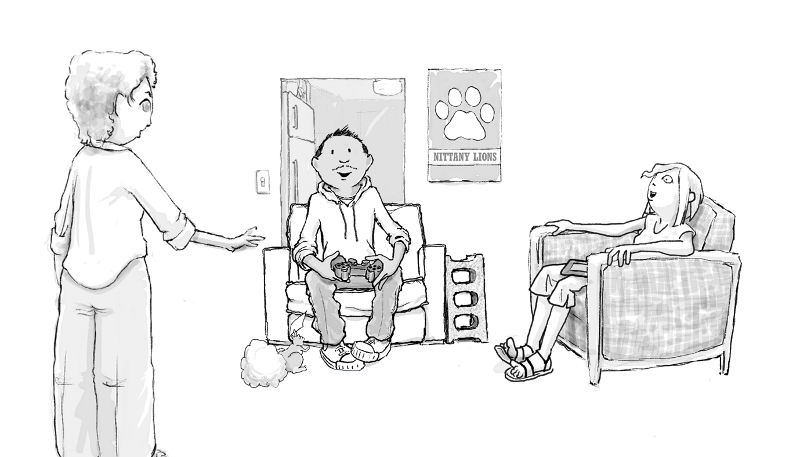 Deena: Hey, how is everyone doing today? Is everyone getting through the data okay?
Deena: Hey, how is everyone doing today? Is everyone getting through the data okay?
Jose: Okay.
Deena: Sage, is something wrong? You haven't said anything.
Sage: There is something I want to ask the group. It seems like the more reading I do, the more difficult it is to remember what I've read, let alone fully understand it. I'm not sure whether it's just me.
Jose: I don't think it's you. In what way does it seem more difficult, Sage?
Sage: You know, I really used to enjoy reading. It always relaxed me. But, now I seem to get frustrated and stressed, even when I read a romance novel.
Jose: Reading a romance book would frustrate me too. I'd sooner read a philosophy text.
Deena: Hey, Jose, some romances are really good books. Have you ever read Gone with the Wind? I think I know what Sage means about a good book being a stress reliever.
Sage: I know, I know. To me, it's kind of like an anytime/anywhere movie in my mind.
When you are reading to collect data and retain information, critical thinking skills should be applied in a systematic way. This is different than passively reading something merely for entertainment in which the story unfolds like a movie in your mind. As you begin to apply active reading skills to reading for entertainment, you may find the movie in your mind becomes more enriched. Properly applied active reading skills will better enable you to recall and apply information you read.
|
Think about a recent reading assignment that was related to an upcoming exam. Describe how you approached this reading assignment by answering the following questions.
|
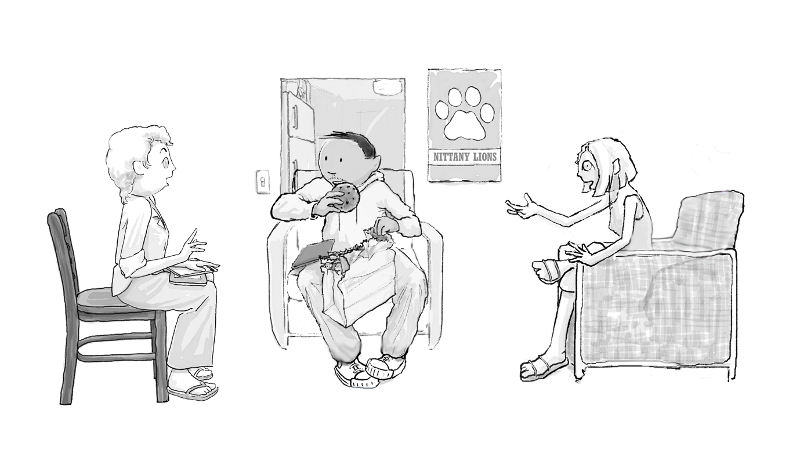 Jose: Well, applying critical thinking skills to entertainment reading makes it more enjoyable for me.
Jose: Well, applying critical thinking skills to entertainment reading makes it more enjoyable for me.
Sage: You do that even though you are not trying to collect data and memorize a lot of the text materials?
Jose: That's right. I don't see TV and movies as an escape, but as things to interpret. Memorizing for the sake of memorizing - like for an exam - is useless in the long run.
Deena: I always thought that memorizing text was a poor approach to learning.
Jose: It is, but if you can't comprehend the material, it seems like the last resort.
Sage: In high school, I had to memorize a lot of lines of text for our drama class. I learned a few tricks about how to do that. I could remember stuff for a while, sometimes, but it doesn't make any sense when the professor asks comprehensive questions involving a summation or an interpretation.
Deena: Any time you seek information through active reading, you are applying critical thinking skills to collect data and process the information for retention. So really, the process used in active reading is similar to conducting an interview. The difference is that you will be conducting the interview with yourself as you interact with the printed materials.
Sage: So reading is not a passive activity?
Deena: Right, Sage. You can't expect words to just jump off the page and into your brain to be instantly recalled. If you want to understand and retain the material, you have to look for the meanings behind the words. Not just the definitions. And you need to conceptualize concepts too.
Sage: Huh?
Jose: In other words, Sage, find the idea or ideas, and determine how they are related to the subject matter you are studying.
Deena: Or in our case, the research we are doing is our context for integrating what we read and what we find.
Sage: Okay. So do you mean that what we are doing is gathering different bits of information as individuals, and then putting them all together?
Deena: That's the way I think about it. We meet, and we conduct, sort of like an interview with each other, to get the information into an idea that means something to all of us and meets our goals.
Sage: So let me see if I follow this. Active reading is like reading the words and then conducting an interview with the book?
Jose: Not really conducting the interview with the book, but rather internally. Just as when you're conducting an interview, you need to follow certain steps to make sure the interview is successful.
Sage: Yeah, that makes sense.
"Survey, question, read, recite, and review" describe the steps in a study/reading method that promotes an active attitude toward learning. When you clear your mind for the task of studying, you are alert and centered. You make yourself ready to learn and remember.
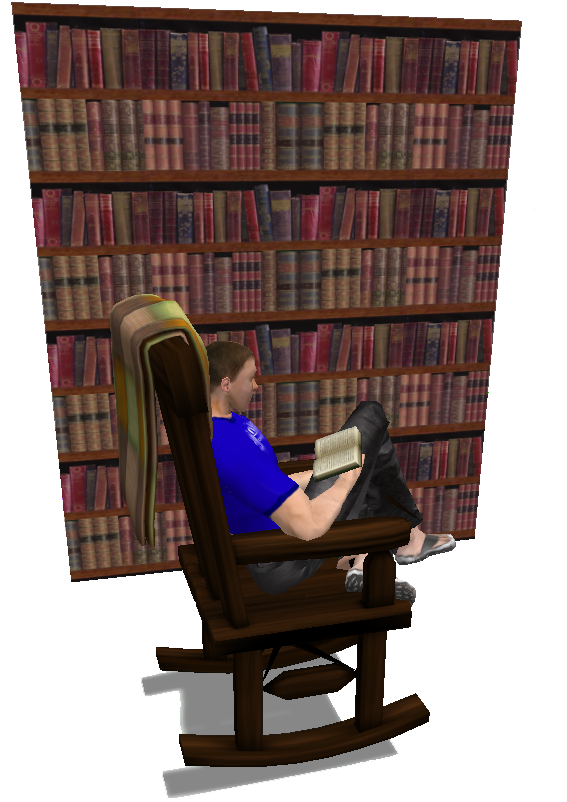 When reading course materials, can you anticipate what the subject matter of the text might cover? Can you anticipate what might appear on your next exam? Active reading involves specific critical thinking skills that help you examine the meaning behind the words and conceptualize concepts. In essence, you engage in an internal interview about the material.
When reading course materials, can you anticipate what the subject matter of the text might cover? Can you anticipate what might appear on your next exam? Active reading involves specific critical thinking skills that help you examine the meaning behind the words and conceptualize concepts. In essence, you engage in an internal interview about the material.
Think back to when you were a child and you were assigned a book to read. Did you do things like count the number of pages or look at the size of the print? Did you look for pictures and read the captions before you started reading the text? If you did, you were previewing or surveying the material.
Previewing is learning about the text before actually reading it. Looking at the number of pages or the pictures is probably not enough to truly help conquer reading assignments at the college level. Practicing effective previewing techniques will help you to maximize your learning from reading.
The first step in previewing is looking over the reading material as it relates to the class you are taking. Here are some additional tips for previewing a reading assignment:
Survey -- in this step, you gather the information necessary to focus and formulate goals.
Contextualize -- looking at texts from a historical, biographical, and cultural context. Most readers interpret material based on personal experiences. But, if you are reading an English novel written in the 1800's from your 21st century perspective, you may not understand the context - such as the class system in the 1800s. Contextualizing helps you think about the author's point of view as it relates to your reading of the text.
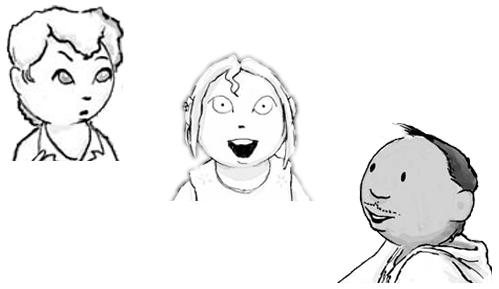 Jose: Okay, so we have the tips for previewing. Are there also tips for when you are actually reading the text?
Jose: Okay, so we have the tips for previewing. Are there also tips for when you are actually reading the text?
Sage: I would imagine so. Deena seems to have tips for everything.
Deena: Sure, okay. There are a series of steps for when you are reading a text. If you use each of these techniques, you will get much more out of what you read than if you use just one or two of them. The second step of active reading involves thorough reading of the material and developing strategies to be used while reading.
Sage: So, what do we do after we preview the text?
Deena: Contextualize the text. In other words, think about the text from the author's point of view, position in history, and cultural surroundings. When you do your research, it is important to try to have an accurate interpretation of information being presented.
Sage: Like a rental apartment being advertised as having early American décor bathroom facilities.
Jose: That could mean an outhouse!
Sage: Exactly -- and would be pretty inconvenient.
Deena: Well, if you just think about historical context, not too many years ago, there were scientists concerned that an ice age was coming and newspapers reported about their concern. If you read one of those articles today, and you didn't know its historical context, you might worry about the coming ice age instead of global warming.
Sage: Or, if you were reading about the reconstruction years in the South after the Civil War, you might want to know whether the author is from the North or the South, or whether he is African-American or Caucasian.
Jose: Depending on the author's point of view and culture, there could be extremely different ways to interpret that period of history.
Sage: I'll say....
[top of page]
Question - helps your mind to engage and concentrate
After you determine the context of the material you are reading, brainstorm questions to which you will expect to find answers in the text. Frame questions - perhaps variations of the headings, sub-headings, or topic sentences - which you make into your personal questions. For each chapter or section in the text, ask yourself questions such as: "What questions are likely to be included on an examination about this material?" Write those questions down.
Ask yourself your brainstorming questions as you read. Questions should be clear and concise. Relate questions directly to the text rather than asking abstract or general questions. View the text as holding a variety of possibilities and more than one concept or idea. Don't develop questions that can be answered with a simple "yes" or "no" response.
|
You can do the following exercise as often as you need to until you automatically ask yourself questions as you actively read a text. Try it with different authors, styles of textbooks, courses, and materials. Newspapers, magazines, journal articles, textbooks, etc. will be constructed in a variety of ways, so you have to be flexible and smart about how you read them. Try reading first with just a paragraph, then gradually expanding your selection to include more paragraphs or whole sections or sub-sections of text. Select a paragraph, or a group of paragraphs, and read it carefully and thoroughly. Put the material aside and answer the following questions:
|
Read
The third step of active reading involves developing strategies to be used during reading, and then actually reading the text. Here are some active reading tips.
[top of page]
Sage: What if our predictions aren't correct? Does that mean we messed up?
Deena: No. That's why we check ourselves. We can't all be perfect all the time. We check our predictions, and then we form new questions and write them down along with the answers.
Sage: So, we might have to change our predictions because they really didn't match the text?
Deena: I would think so. After all, we didn't write the text, and our predictions were conceived before we did the reading. Part of learning is adding to or changing what we already know, and modifying our attitudes and points of view. Basically, our prior knowledge is what we use to come up with predictions in the first place. When we find our predictions are incorrect, it means we are getting something from the process of active reading.
Jose: So, we need to revise our predictions often as we read the text?
Deena: Yes, along with forming new questions and answers.
Jose: If I follow what you have just said, by becoming involved with the text, we will remember it better.
Deena: Right, Jose. We become active learners by reading in this way.
[top of page]
When you Recite, you retrain your mind to concentrate and learn as you read.
|
Take a minute to think about what you do when you read.
|
Deena: Well, don't forget we need to review what we read after we finish reading. So far we have covered previewing the text, thinking about the information we are reading in context, and activities to do when reading the text.
Jose: So, are we closing in on the finish line?
Deena: Yes. What we want to do next is to review the text, especially those things that challenge our attitude about something, our beliefs, or responses to current issues, and to look for patterns among these things.
Sage: How do we organize this?
Deena: You may want to outline themes and summarize sections. We could look for the critical links in the patterns.
Sage: To me, outlining means distinguishing between main ideas and supporting ideas, consolidating examples, and then writing them down.
Deena: Condensing and putting things into your own words and ideas helps accomplish the review process. Keep in mind that when you summarize, you also want to test the credibility, logic, and emotion of what you have read into it.
Jose: Okay, so if I felt like it wasn't true or valid I should challenge it?
Deena: That's right. The author will make an argument for an opinion or belief, but their conclusions may not be the same as yours. What works for someone else may not be appropriate for you.
Sage: So, active reading is like having a conversation with the author who could be in front of us in the classroom or in print.
Deena: Very good, Sage. But don't forget that you are also having a continuous interview with yourself.
Jose: So, I think we've pretty much covered what to do when reviewing. You definitely have the idea about active reading.
Deena: But, remember that the important idea is going through the process and getting as much as you can from the written information.
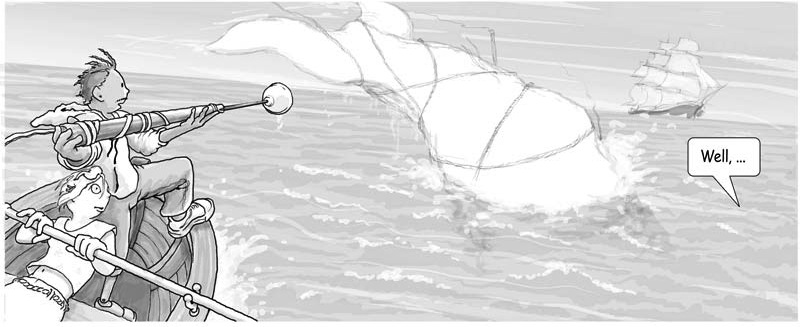
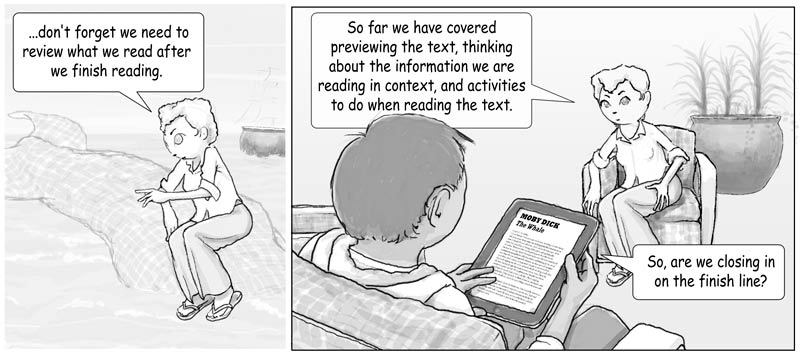
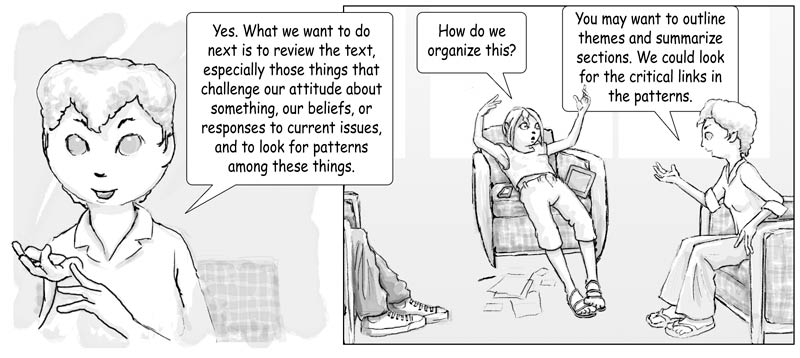
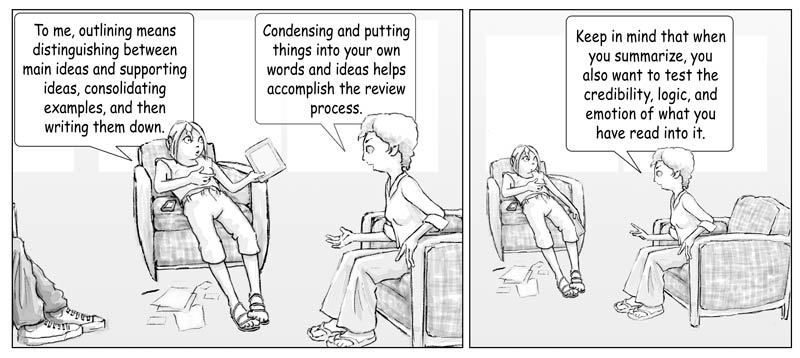
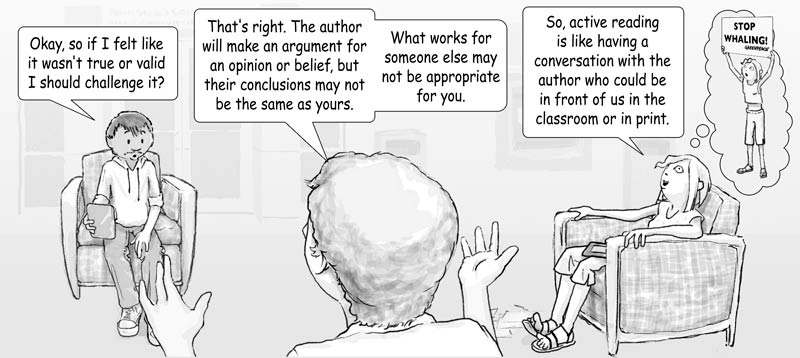
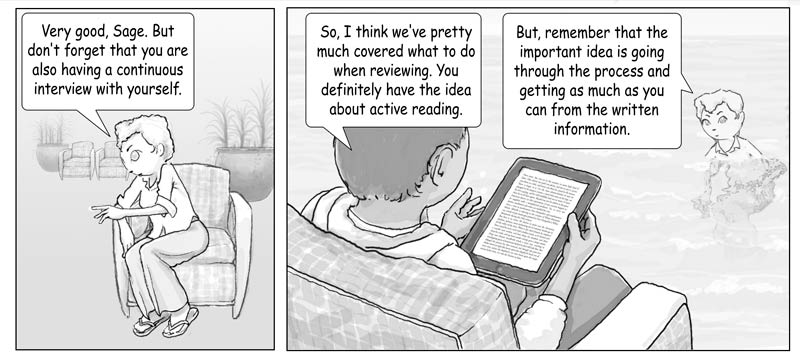
Reviewing will refine your mental organization and begin building memory. Here are some tips for "Reviewing," the fifth step in active reading.

As you can see from reading about the SQ3R approach to active reading described above, reading for college is not a passive activity. Important facts, information, and concepts will not just jump off the page and into your brain for instant recollection. In order to comprehend and retain the material you read, look for the intent and the meanings behind the words.
Active reading involves specific critical thinking skills that help you examine meaning and put concepts into context. In essence, you engage in an internal interview with yourself about the material.
Activity 5: Practicing Active ReadingHere is a passage on the history of Penn State taken from "The Penn State Experience: A freshman guide to life outside the classroom" (Wadsworth Publishing Company, 1999). Read the passage using the Active Reading skills you have learned in this tutorial, then take the quiz to see how you did. In 1855, the Pennsylvania legislature chartered the Farmer's High School. At the first trustees' meeting, the main order of business was obtaining a location for the school. The board considered proposals from five people who were willing to provide 200 or more acres of land. Among the offers was that of General James Irvin of Bellefonte, who could provide a 200-acre tract of land from his large holdings. All five locations were visited, and the committee ultimately accepted Irvin's offer after local citizens sweetened the deal pledging an additional $10,000 for the school. An architect was hired to design the main building, a five-story stone structure composed of three wings, with rooms for up to 400 students, faculty living quarters and classrooms. With $100,000 from various sources, construction began. Tuition and room and board charges were fixed at $100 per year, and on February 16, 1859, 69 students arrived to begin their studies. The school's address was simply, "Farm School." In 1887, the first student newspaper was published. "Free Lance" was a monthly publication and sold for 15 cents. In 1941, the Nittany Lion Shrine was commissioned with the 1940 Class Gift. Heinz Warnake was selected to sculpt the Lion, and he worked on campus in full view of the students. It was completed in four months, carved from a thirteen-ton block of limestone. In the 1980s, a cast of the lion was made and stored in an undisclosed location after part of an ear was broken off. In 1947, Henry Varnum Poor finished the first of Old Main's frescoes, depicting the signing of the Morrill Land-Grant Act of 1862 that paved the way for Penn State's land grant mission of outreach to the citizens of Pennsylvania. In 1982, Penn State won its first NCAA football championship and a second in 1986 to celebrate its 100th anniversary in the sport. Penn State joined the Big Ten Conference in 1992 in all sports and to facilitate academic progress among the Big Ten institutions. In 1997, Penn State reorganized its Commonwealth Educational System. In its place, it established a "Commonwealth College" with 14 campuses and allowed the formation of three additional colleges: Berks-Lehigh Valley College, Abington College and Altoona College. These new academic colleges can establish a limited number of four-year baccalaureate programs that will benefit their communities. |

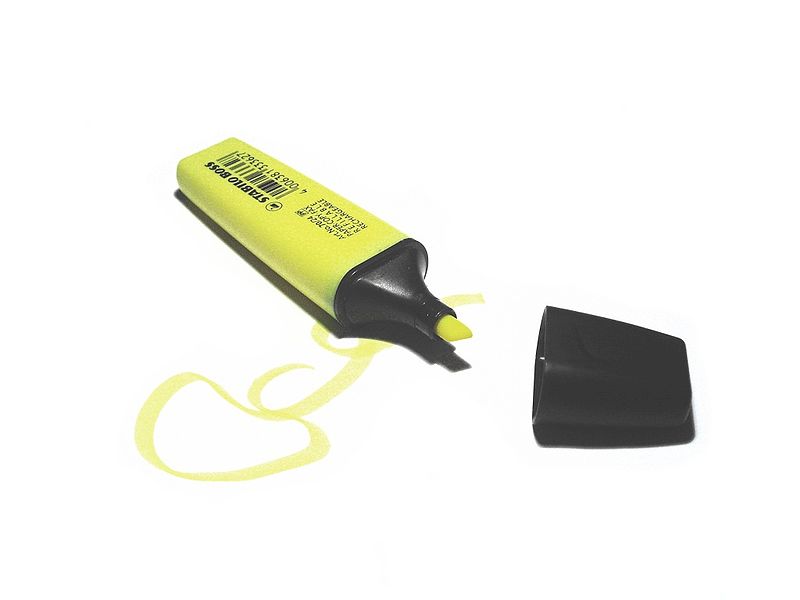

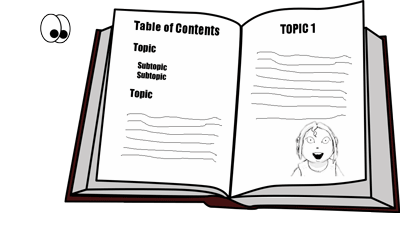
Taking notes on reading requires the same skills that apply to class notes: observation, reading, and review. You should take notes on reading:

Deena: I can see how active reading can be applied to many things we do. It can especially be applied to our individual and group research projects.
Jose: Our data collection? Our analysis?
Sage: Our report!
Deena: All of it. I was also thinking that it would help us to become better critical thinkers on a daily basis.
Sage: Is that sort of like being aware of multiple possibilities?
Jose: And not just to accept everything we read as absolute. Not only what we read, but what we hear too. I think it can also make a difference in the way we write.
Deena: Yeah, particularly if our audience is an active reader.
Sage: Wow! That's a really good point, Deena.
Jose: Speaking of questioning things, where did you get this information about active reading anyway?
Deena: I sort of put it together from several sources. I picked out what I thought was the best information. If anyone has some good Web sites or resources, let me know.
* Indicates that the original Website is no longer available.
There are a variety of goals and objectives involved in active reading. They may vary according to discipline or your major study area. You may be concerned with active reading based on how you will be evaluated in the course, and how adept you are at that form of evaluation. For example, some students handle multiple choice and fact-based examinations very well, but are not particularly comfortable with essay formats.
Take a minute to examine the objectives of courses you are taking, or any form of learning in which you may be involved. For example, do you need to be able to recall a lot of definitions or facts? Are you concerned with solving problems? Have you been asked to analyze a text? By thinking about your objectives, and then identifying strategies you might use to accomplish those objectives, you can begin to develop an approach to active reading that suits your personal needs and requirements as well as the requirements of the learning situation.
Following are the assignments embedded in the Active Reading tutorial:
This tutorial is related to other istudy tutorials on personal effectiveness, including note taking, time management, stress management, conflict management, and brainstorming. Therefore, it is recommended that instructors introduce this tutorial to students in conjunction with other personal effectiveness tutorials.
Discussion
Note : This is an excellent opportunity to utilize and reinforce the cooperative learning techniques found in the iStudy Cooperative Learning tutorial.
Instructors may wish to provide an introduction and overview of active reading, starting with the following information:
When you are reading to collect data and retain information in memory, critical thinking skills need to be applied in a systematic way. This differs from reading something which may be strictly for entertainment in an passive mode where the story unfolds like a movie in your mind. However, as you begin to apply active reading skills to entertainment reading, you may find the mind movie becoming more enriched.
Any time you seek information through active reading, you are applying critical thinking skills to collect data and processing the information for retention. In essence, the process used in active reading is similar to conducting an interview. The difference is that you will be conducting the interview with yourself as you interact with the printed materials.
Properly applied active reading skills will enable you to be better able to recall and apply information you read.
Ask the students to answer the following questions for themselves about a recently-read class article:
Conclude a lesson by stating:
Through observing both the group's and the individual's activity, the instructor may assess student performance.
|
Where |
Domain |
Activities |
% |
|---|---|---|---|
|
iStudy Tutorial |
Knowledge |
The student can define active reading with its importance. |
|
|
In-Class |
Application |
The student can engage in active reading skills by use of previewing, contextualization, brainstorming, prediction, and reviewing of text. |
|
|
iStudy Tutorial |
Synthesis |
The student can reflect on his/her own active reading skills and self-assess his/her current use of active reading skills by identifying his/her weaknesses as well as by making plans to eliminate those weaknesses. |
|
|
|
|
|
100% |